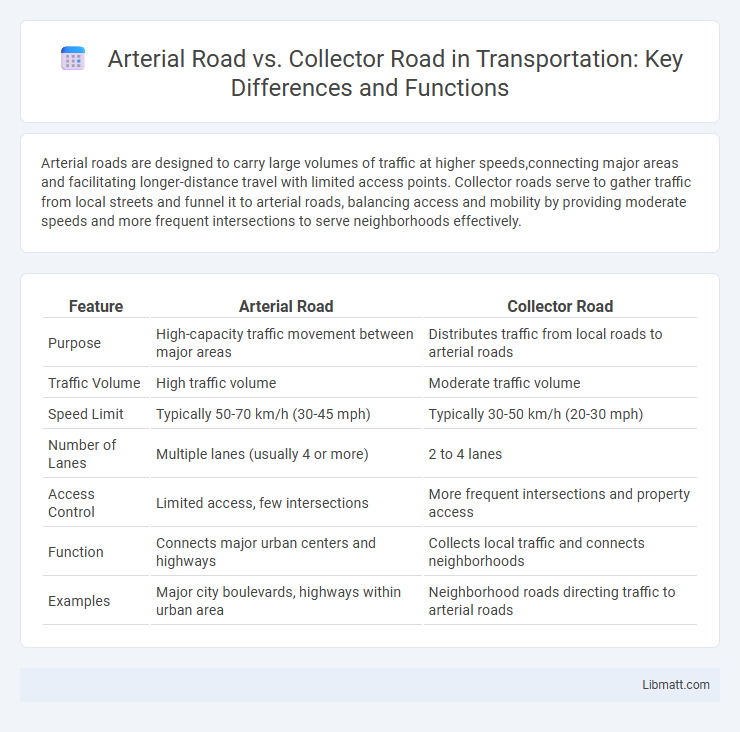Arterial roads are designed to carry large volumes of traffic at higher speeds,connecting major areas and facilitating longer-distance travel with limited access points. Collector roads serve to gather traffic from local streets and funnel it to arterial roads, balancing access and mobility by providing moderate speeds and more frequent intersections to serve neighborhoods effectively.
Table of Comparison
| Feature | Arterial Road | Collector Road |
|---|---|---|
| Purpose | High-capacity traffic movement between major areas | Distributes traffic from local roads to arterial roads |
| Traffic Volume | High traffic volume | Moderate traffic volume |
| Speed Limit | Typically 50-70 km/h (30-45 mph) | Typically 30-50 km/h (20-30 mph) |
| Number of Lanes | Multiple lanes (usually 4 or more) | 2 to 4 lanes |
| Access Control | Limited access, few intersections | More frequent intersections and property access |
| Function | Connects major urban centers and highways | Collects local traffic and connects neighborhoods |
| Examples | Major city boulevards, highways within urban area | Neighborhood roads directing traffic to arterial roads |
Introduction to Road Hierarchies
Arterial roads serve as primary routes designed to facilitate high-capacity traffic flow between major urban centers and regions, prioritizing speed and efficiency for long-distance travel. Collector roads function as intermediate links, gathering traffic from local streets and directing it toward arterial roads while balancing accessibility and mobility within neighborhoods. Understanding this hierarchy helps you navigate traffic systems effectively by recognizing the role each road type plays in overall transportation network planning.
Defining Arterial Roads
Arterial roads are high-capacity urban streets designed to deliver traffic efficiently between major destinations and across regions, prioritizing mobility over direct property access. These roads typically feature multiple lanes, higher speed limits, and limited intersections to facilitate uninterrupted traffic flow. Unlike collector roads, which balance access and mobility by distributing traffic from local streets to arterial roads, arterial roads serve as the main corridors for long-distance and through traffic within a city's transportation network.
Defining Collector Roads
Collector roads serve as intermediate routes designed to gather traffic from local streets and channel it towards arterial roads, facilitating efficient movement within urban and suburban areas. These roads balance access and mobility, typically featuring moderate speed limits and accommodating various vehicle types while connecting neighborhoods to major traffic corridors. Understanding the role of collector roads can enhance your ability to navigate urban infrastructure effectively and support optimal traffic flow management.
Key Differences Between Arterial and Collector Roads
Arterial roads are designed for high-capacity, long-distance travel, efficiently connecting major urban centers and handling large traffic volumes at higher speeds. Collector roads serve as intermediate routes, gathering traffic from local streets and channeling it towards arterial roads, balancing mobility with accessibility in neighborhoods. Your choice between arterial and collector roads depends on the need to prioritize either fast, continuous traffic flow or local access and connectivity.
Traffic Volume and Capacity
Arterial roads are designed to handle high traffic volumes and provide major routes for long-distance and through traffic with higher capacity, often featuring multiple lanes and limited access points. Collector roads serve to gather traffic from local streets and funnel it to arterial roads, accommodating moderate traffic volumes with lower capacity and more frequent access points. Your travel efficiency depends on choosing arterial roads for faster, high-capacity routes and collector roads for localized traffic flow management.
Speed Limits and Traffic Flow
Arterial roads typically have higher speed limits ranging from 40 to 60 mph, designed to facilitate efficient long-distance travel and high traffic volumes. Collector roads, by contrast, have lower speed limits usually between 25 and 40 mph, balancing moderate traffic flow while providing access to local streets. Your choice between the two impacts travel time and congestion, with arterial roads optimizing speed and capacity while collector roads prioritize access and safety.
Accessibility and Connectivity
Arterial roads prioritize high-capacity traffic flow, offering limited accessibility to adjacent properties to maintain efficient connectivity between major urban areas and highways. Collector roads balance accessibility and connectivity by linking local streets to arterial roads, providing moderate access to residential and commercial properties while facilitating smoother traffic distribution within neighborhoods. This hierarchy ensures that arterial roads handle long-distance travel efficiently, while collector roads support local traffic movement and access.
Safety Considerations
Arterial roads prioritize high-speed traffic flow, requiring robust safety measures such as controlled access points and clear lane markings to minimize collision risks. Collector roads, designed to funnel traffic from local streets to arterials, often incorporate features like lower speed limits and pedestrian crossings to enhance safety for mixed traffic users. Effective safety considerations on both road types include proper signage, lighting, and traffic calming strategies to reduce accidents and improve overall road user protection.
Urban Planning and Road Design
Arterial roads in urban planning function as primary routes designed to facilitate high-capacity traffic flow between major city areas, prioritizing speed and efficient movement over local access. Collector roads serve as intermediate pathways connecting arterial roads with local streets, balancing moderate traffic volumes while providing access to residential neighborhoods and commercial zones. Road design for arterial routes emphasizes wider lanes, limited intersections, and controlled access points, whereas collector roads incorporate features supporting both traffic flow and direct property access, such as more frequent intersections and pedestrian accommodations.
Choosing the Right Road Type for Communities
Arterial roads prioritize high-capacity traffic flow, efficiently connecting major urban centers and facilitating long-distance travel, making them ideal for busy commercial corridors. Collector roads balance access and mobility by linking local streets to arterial roads, supporting moderate traffic volumes and providing direct access to residential neighborhoods. Selecting the right road type depends on community needs, traffic demand, land use patterns, and the goal of optimizing connectivity while minimizing congestion and promoting safety.
arterial road vs collector road Infographic

 libmatt.com
libmatt.com